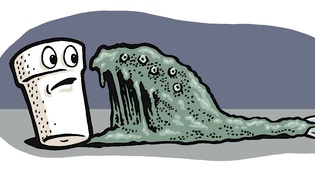 loading
loading
FindingsA fungus that eats polyurethane Gregory NemecView full image
A group of student bioprospectors from Yale has struck environmental gold in the jungles of Ecuador. The students, through the annual Rainforest Expedition and Laboratory course taught by molecular biochemistry professor Scott Strobel, have discovered a fungus with a powerful appetite for polyurethane. That common plastic often winds up buried in landfills, where it can remain, largely unaltered, for generations. In the September issue of Applied and Environmental Microbiology, Jonathan Russell ’11 and his colleagues describe how they isolated, from plants collected during the class’s two-week spring trips, a fungus they identified as Pestalotiopsis microspora—and then discovered its unique polyurethane-digesting talents. “Many microbes can do cool tricks, like degrading pollutants,” says Russell, who is beginning a doctoral program in biology at Harvard. On his list for the trip were plants producing latexes and other resins; they can harbor fungi or bacteria that may make a living off the natural plastic-like materials. The plants were identified in the field by botanist Percy Núñez, a professor at the National University of San Antonio Abad in Cusco, Peru. At Yale, Pria Anand ’10, an alumna of the course, isolated P. microspora samples and showed that they could do something no one had seen: live and prosper on a steady diet of polyurethane alone. Most intriguing, the fungus is believed to do this even under the oxygen-free conditions that would prevail at the bottom of a landfill. Russell has isolated an enzyme the fungi use to accomplish the degradation, and it’s possible that this molecule alone could be useful in eliminating polyurethane. |
|
3 comments
-

Kyme, 6:08pm October 16 2014 |  Flag as inappropriate
Flag as inappropriate
-

John Bache, 2:19am December 18 2014 |  Flag as inappropriate
Flag as inappropriate
-

Patricia Casey, 2:50am July 29 2015 |  Flag as inappropriate
Flag as inappropriate
The comment period has expired.SUPER COOL
Not so good for the underground cables ... ?
I would like to know, what the impact, of these fungi would be on the ocean.
Could it be used on the Plastic Island?